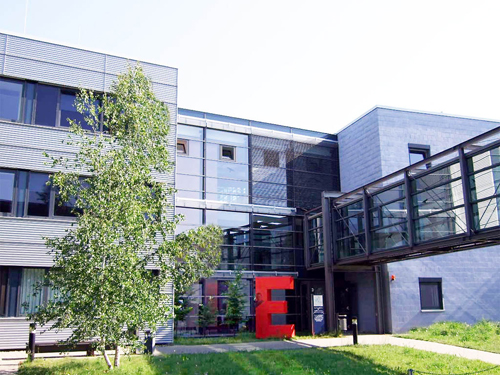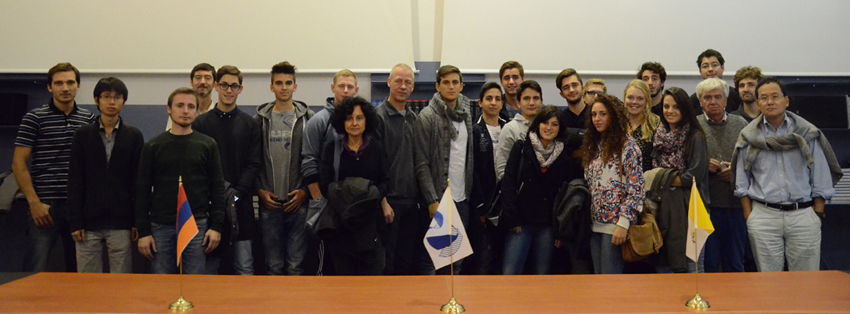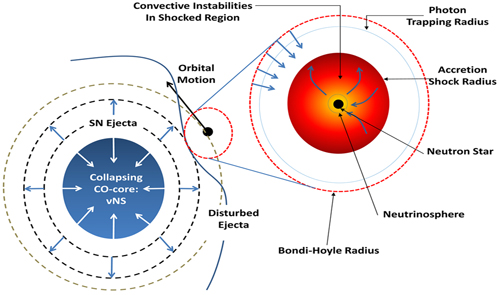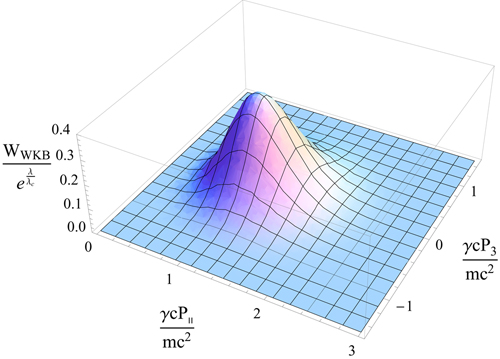

| Newsletter Italian July/October |

|

|





ICRANet Newsletter
Special Issue
July/October
1° Meeting scientifico ICRANet in Armenia
Buchi neri: le più grandi fonti di energia nell'Universo. Principali risultati scientifici
Dopo la cerimonia di apertura il Prof. Ruffini ha presentato la sua lezione dal titolo: “Black Holes, Gamma-Ray Burst and Supernovae. The Leading Progress in Physics and Relativistic Astrophysics” che ripercorre la storia della scoperta del GRB così come i recenti risultati di osservazione / modellazione dei GRB e anche i recenti progressi di comprensione del rapporto tra GRB e supernovae.
Nella principale sezione di questo incontro armeno, esperti provenienti da tutto il mondo, tra cui Christoph H. Keitel (Germania), Karen Hatsagortsyan (Armenia) e Antonino Di Piazza (Italia, ricercatore presso il Max Planck Institute di Heidelberg, Germania) hanno presentato i loro studi sulla fisica nucleare utilizzando laser intensi, fotoni ad alta energia in collisione con fasci di luci laser e una revisione generale sui fenomeni di forti campi elettromagnetici. Due relazioni sull’astrofisica ad alta energia dei raggi gamma sono state presentate da Razmick Mirzoyan (Germania-Armenia) e Alessandro De Angelis (Italia). Mirzoyan ha mostrato i più recenti risultati delle osservazioni MAGIC di sorgenti galattiche (supernova W51 e nebulose CRAB), di sorgenti extragalattiche (IC 310, MRK 412 ecc) e di luci di stato corrente della matrice condotte attraverso il telescopio Cherenkov. L’astrofisica ad alta energia di raggi gamma ad energie relativamente basse (circa 10 GeV) con rivelatori Cherenkov sono stati invece presentati da De Angelis. Un gruppo di studenti ICRANet (dottorandi, membri dell’ICRANet Faculty) hanno presentato i risultati dei loro recenti studi sul GRB e le connessioni tra GRB e supernovae. La fisica delle stelle di neutroni e i più recenti progressi sono stati discussi da Jorge Rueda, Riccardo Belvedere e Kuantay Boshkayev. Inoltre, Eckhard Strobel, Yuanbin Wu e Hendrik Ludwig ed altri hanno presentato la loro ricerca sul numero di forti campi elettromagnetici e discusso con loro tutti i fenomeni e le relative applicazioni in fisica e astrofisica. Paolo Giommi e lo studente del dottorato EMJD Bruno Sversut hanno presentato un campione di “high synchrotron peaked blazars”, interessanti per le osservazioni TeV. La loro conclusione è che la maggior parte di essi potrebbero essere rilevati dalla prossima generazione di telescopi Cherenkov, invece altri, sotto altra forma, anche da parte degli attuali telescopi Cherenkov. Infine il Prof. Claus Laemmerzahl (Germania) ha presentato un talk su “Test particle motion in regular black hole space-times”.
Procedono i lavori per gli atti del meeting Zel'dovic-100
Tutti i contributi per gli atti della conferenza “Zel'dovic-100” svoltasi a Minsk (Bielorussia) nel marzo 2014 sono arrivati all’ICRANet: tra questi, 18 contributi per la sessione plenaria e 32 per le sessioni parallele. Gli atti saranno pubblicati entro la fine del 2014 in numeri speciali delle riviste Astronomy Reports (per la sessione plenaria) e Nonlinear Phenomena in Complex Systems (per le sessioni parallele). Entrambe le riviste sono indicizzate in Scopus, mentre Astronomy Reports è anche indicizzato in Thomson Reuters. I redattori sono Sergei Kilin (Accademia Nazionale delle Scienze della Bielorussia), Remo Ruffini (ICRANet) e Gregory Vereshchagin (ICRANet).
Pubblicazione dei lavori del 13° incontro italo-coreano sull’Astrofisica relativistica
In questo incontro, che si svolge ogni due anni alternativamente in Italia e in Corea (vedi: qui), oltre a molti docenti coreani, ricercatori e studenti, hanno partecipato e hanno presentato i loro lavori scientifici più di 10 partecipanti dell’ICRANet. I loro contributi sono stati recentemente pubblicati nell’importante "Journal of Korean Physical Society". A questo link è possibile leggere un’anteprima: http://link.springer.com/journal/40042/65/6/page/1
Nuova collaborazione tra ICRANet e l'Istituto A. Einstein di Potsdam
Nel mese di luglio l’ICRANet ha avviato il nuovo programma "Soluzioni esatte nella Relatività Generale supersimmetrica" in collaborazione con il gruppo del Prof. Hermann Nicolai presso l'Albert Einstein Institute di Potsdam (Germania). Questa nuova collaborazione si aggiunge ora alla lista delle ricerche dell’ICRANet nel campo delle "soluzioni esatte delle equazioni di Einstein e Einstein-Maxwell".
L'obiettivo principale è la costruzione dei più esatti solitoni supergravitazionali.
Firmati nuovi accordi in Brasile, Italia e Messico
Continua la fervida attività diplomatica del prof. Ruffini in Sudamerica, dove, tra luglio e agosto, sono stati firmati nuovi e importanti accordi con alcune grandi università in Brasile e in Messico.
Segnatamente, il primo luglio è stato firmato a Niterói (Brasile) l’accordo con l’UFF - Universidade Federal Fluminense, il 9 luglio a Città del Messico l’accordo con la UAM - Universidad Autónoma Metropolitana, il 26 agosto a Florianópolis (Brasile) l’accordo con l’UFSC - Universidade Federal de Santa Catarina e il 29 agosto, sempre in Brasile, l’accordo con l’UFPE - Universidade Federal de Pernambuco. Il primo agosto, a Roma, è stato firmato l’accordo con il CNR – Centro Nazionale delle Ricerche, presieduto dal prof. Luigi Nicolais.
Grande successo per la “Notte dei ricercatori” all’ICRANet
Per il secondo anno consecutivo il Centro ICRANet di Pescara ha aderito alla manifestazione nazionale “Notte dei ricercatori 2014” per promuovere presso il grande pubblico l’attività di ricerca in Italia. Nella mattinata di venerdì 26 settembre gli scienziati dell’ICRANet hanno presentato gli argomenti delle loro ricerche a circa 150 studenti dell’ultimo biennio dei licei di Pescara. Inoltre la nostra sede centrale è rimasta aperta anche in serata con un programma di visite guidate aperte al pubblico, che ha potuto così osservare con i propri occhi i locali in cui gli scienziati dell’ICRANet approfondiscono la nostra conoscenza delle stelle e delle leggi che regolano l’Universo.
Infine, presso il prestigioso Aurum di Pescara, diversi scienziati dell’ICRANet hanno dato vita a un ricco programma di conferenze e osservazioni al telescopio: il Prof. Ruffini ha parlato di “Supernovae, Gamma Ray Burst e Buchi Neri” e il dott. Costantino Sigismondi ha approfondito il tema “Novae e Supergiganti Variabili”. Inoltre fino a mezzanotte il Dott. Luca Izzo e il Dott. Costantino Sigismondi hanno condotto osservazioni al telescopio sul Terrazzo Flaiano sia del sole sia di luna e stelle.
Delegazione di studenti danesi in visita al Centro ICRANet di Pescara
Il 23 ottobre scorso una delegazione di 6 studenti danesi, provenienti da Svendborg e guidati dal prof. Mads Fjeldvig Gammeltoft, ospiti degli studenti della prof.ssa Alessandra Palma, del Liceo Scientifico “Leonardo da Vinci” di Pescara, hanno fatto visita al nostro centro di Pescara, dove hanno assistito, dopo il saluti del Direttore, prof. Remo Ruffini, alla lezione dal titolo “Light and the exploration of the Universe” tenuta dal dott. Gregory Vereshchagin, membro della faculty ICRANet.
Presentato il poster del quattordicesimo Marcel Grossman Meeting - Roma, Italia, 12-18 Luglio 2015
Il quattordicesimo Marcel Grossmann meeting si terrà a Roma, in Italia, presso l'Università di Roma "Sapienza", tra il 12 e il 18 luglio, 2015. Dal 1975, i Marcel Grossmann meeting sono stati organizzati in modo da fornire opportunità per discutere le più recenti scoperte nel campo della gravitazione, della relatività generale e delle teorie di campo relativistiche, sottolineando fondamenti matematici, previsioni fisiche e prove sperimentali. L'obiettivo di questi incontri è quello di sollecitare lo scambio tra gli scienziati che possono approfondire la nostra comprensione delle strutture spazio-temporali, nonché per esaminare lo stato di esperimenti in corso volti a verificare la teoria della gravitazione di Einstein sia da terra che dallo spazio. I precedenti MG meetings si sono tenute a Trieste (1975 e 1979), Shanghai (1982), Roma (1985), Perth (1988), Kyoto (1991), Stanford (1994), Gerusalemme (1997), Roma (2000), Rio (2003), Berlino (2006), Parigi (2009) e Stoccolma (2012). Gli scienziati interessati potranno contattare un membro di uno qualsiasi dei comitati organizzatori o la segreteria della conferenza.
Questa edizione del Marcel Grossmann Meeting coincide con il 100° anniversario delle equazioni di Einstein, l'Anno Internazionale della Luce 2015, organizzato dall'UNESCO, e il Golden Jubilee dell’astrofisica relativistica e saranno celebrati dal MG14 e altri incontri satelliti in Armenia, Brasile, Cina, Francia, Germania, India, Israele, Corea, Messico e Stati Uniti. Il poster è pronto e può essere scaricato al seguente indirizzo: http://www.icra.it/mg/mg14/MG14_poster.pdf La pianificazione del programma scientifico è in corso, con il rinnovo di sessioni parallele del passato e l'introduzione di nuove. Sito web: http://www.icra.it/MG/mg14/ E-mail: mg14@icra.it
ICRANet Faculty and Student’s Scientific Research articles
GRB 130427A and SN 2013cq: A Multi-wavelength Analysis of An Induced Gravitational Collapse Event
R. Ruffini, Y. Wang, M. Kovacevic, C.L. Bianco, M. Enderli, M. Muccino, A.V. Penacchioni, G.B. Pisani, J.A. Rueda
Accepted by ApJ In the particle physics, the interaction between particles generates new particles, named as S-matrix. For instance, a pair of quark and anti-quark produces W/Z boson and Higgs boson, the outcome of electron and positron interaction could be a pair of muon and anti-muon, the duration of such interaction is fleeting, the above two reactions only take 10−26 s and 10−23 s respectively. In the marco-scale astrophysics, some phenomena are apparently similar to the micro-scale particle physics, a famous example is the similarity of electron and blackhole, both can be completely characterized by only mass, electric charge, and angular momentum. Here in our new accepted Astrophysical Journal paper, we introduce a new celestial matrix, C-matrix, an analogue to the S-matrix (Fig.1). C-matrix depicts a binary system composed of one neutron star and one massive star as the initial state, and the products after about 100s interaction are one new neutron star and one black hole. The story of this process can be outlined as: The massive star undergoes a supernova and eject its massive shell, the companion neutron star accretes the ejecta until reaching its critical mass and collapses into a black hole, simultaneously an over critical electrical field is generated around the black hole and electro-positron plasma are produced from it, this plasma flow expands ultra-relativisticly and collides with the inter-stellar medium, which gives origin to the gamma-ray burst (GRB), GRB is considered as an energetic explosion which emits huge abundant photons, mainly the gamma-rays. On April 27, 2013, such aforementioned event occurred and triggered Fermi satellite, later various satellites and telescopes joined the observation. This event was named as GRB 130427A, it is one of the few GRBs which has hundreds of seconds simultaneous data in the optical, X-ray and GeV emission, especially precious is its GeV emission, due to the long duration, high intensity and containing the highest energy photon (95.3 GeV) ever observed in GRBs. We proceeded to make a multi-wavelength analysis. The high energy GeV emission appears to be detectable at the end of the prompt radiation phase(∼ 20s), when the fluence of X-ray and γ-ray of the prompt exponentially decrease and becomes transparent for GeV photons. After 200s, the Lorentz factors of X-ray and GeV are very different, and their physical origin are necessarily different. The high energy can originate from the interaction of some of the physical components (e.g., neutron star and black hole) newly created in the C-matrix. ![fig1 [fig1]](newsletters/luglio2014/fig1_small.jpg)
Figure 1: Three different matrices in fundamental physics. The first is the quark matrix leading to a Higgs boson. In the middle is the classical electron-positron pair matrix, generating an muon and anti-muon pair. The third matrix is the celestial one, which is considered in the present work. ∆t is the duration of intermediate state. The interaction of the GRBs with the SN ejecta may well generate the X-ray emission and the associated thermal component. By analyzing the X-ray data from 195s to 461s, a crucial evidence was found, that adding a blackbody component could efficiently improve the fitting (Fig. 3), the obtained blackbody temperature is in the range of 0.3 KeV to 0.5 KeV, the radiation radius is deduced from about 7 × 1012 cm to 2.8 × 1013 cm, with the expansion speed at 0.8c, c is the speed of light. These above value is typical for the supernova ejecta accelerated by the collision with GRB outflow. GCN 14526: The late X-ray observations of GRB 130427A by Swift-XRT clearly evidence a pattern typical of a family of GRBs associated to supernova (SN) following the Induce Gravitational Collapse (IGC) paradigm (Rueda & Ruffini 2012; Pisani et al. 2013). We assume that the luminosity of the possible SN associated to GRB 130427A would be the one of 1998bw, as found in the IGC sample described in Pisani et al. 2013. Assuming the intergalactic absorption in the I-band (which corresponds to the R-band rest-frame) and the intrinsic one, assuming a Milky Way type for the host galaxy, we obtain a magnitude expected for the peak of the SN of I = 22 - 23 occurring 13-15 days after the GRB trigger, namely between the 10th and the 12th of May 2013. Further optical and radio observations are encouraged. After the first days observation, we found that the X-ray afterglow of GRB 130427A overlaps other GRBs induced by C-matrix (Fig.4), we concluded that this new GRB shared the same mechanism, which means a supernova is inevitable in the system though the optical signal is too weak too be observed, immediately we sent a letter to GCN on May 2, 2013, predicting that the optical R-band of a SN will reach its peak magnitude in about 10 days in the cosmological rest-frame on the basis of the IGC paradigm, and we encouraged observations. ![fig2 [fig2]](newsletters/luglio2014/fig2_small.jpg)
Figure 2: Flux of first 700 s. Blue points are the Fermi-LAT high energy emission from 100 MeV till 100 GeV, grey dotted line represents the Fermi-GBM, from 10 keV to 900 keV, green dashed line represents the photons detected by Swift BAT from 10 keV to 50 keV, and red solid line is the soft X-ray Swift-XRT detection, in the range of 0.3 KeV to 10 KeV. From this figure, clearly the Fermi-LAT emission reaches highest fluence at about 20 s while the gamma-ray detected by Fermi-GBM releases most of the energy within the first 10 s. ![fig3 [fig3]](newsletters/luglio2014/fig3_small.jpg)
Figure 3: Spectral fitting of three time intervals (196s - 246s, 246s - 326s, 326s - 461s) in Episode 3, data come from Swift-XRT (0.3 KeV - 10 KeV, without pile-up area). Black points are the deduced data, green dashed line presents the thermal component, blue long-dashed line is the power law component, and red line shows the combination of these two components. Clearly the flux of thermal component drops and the temperature decreases along the time. ![fig4 [fig4]](newsletters/luglio2014/fig4_small.jpg)
Figure 4: Overlapping of GRB 130427A and GRB 060729. Green cross is the light curve of GRB 060729. Red triangle and orange dots represent the light curve of GRB 130427A respectively before and after May 2, 2013. The vertical line marks the time of 2 × 104 s which is the lower limit for the domain of validity of the Pisani relation prior to GRB 130427A.
Letter in collaboration with Pror. Fryer, Los Alamos:
Hypercritical Accretion, Induced Gravitational Collapse, And Binary-Driven Hypernovae
Chris L. Fryer, Jorge A. Rueda, Remo Ruffini
ApJ Letters 793, 36 (2014) The induced gravitational collapse (IGC) paradigm has been successfully applied to the explanation of the concomitance of gamma-ray bursts (GRBs) with supernovae (SNe) Ic. The progenitor is a tight binary system composed by a carbon-oxygen (CO) core and a neutron star (NS) companion. The explosion of the SN leads to hypercritical accretion onto the NS companion which reaches the critical mass, hence inducing its gravitational collapse to a black hole (BH) with consequent emission of the GRB. The first estimates of this process were based on a simplified model of the binary parameters and the Bondi-Hoyle-Lyttleton accretion rate. We present here the first full numerical simulations of the IGC phenomenon. We simulate the core-collapse and SN explosion of CO stars to obtain the density and ejection velocity of the SN ejecta. We follow the hydrodynamic evolution of the accreting material falling into the Bondi-Hoyle surface of the NS all the way up to its incorporation to the NS surface. The simulations go up to BH formation when the NS reaches the critical mass. For appropriate binary parameters the IGC occurs in short timescales (100-1000s) owing to the combined effective action of the photon trapping and the neutrino cooling near the NS surface. We also show that the IGC scenario leads to a natural explanation for why GRBs are associated only to SN Ic with totally absent or very little helium.
Semiclassical pair production rate for time-dependent electrical fields with more than one component: WKB-approach and world-line instantons
Strobel, Eckhard; Xue, She-Sheng
Nuclear Physics B 886, 1153 (2014) Description: The Schwinger-effect describes how pairs of electrons and positrons can be produced from the vacuum with the help of a very strong electric field. While this effect is believed to play a important rule in astrophysics, especially for gamma ray burst, it has never been observed directly in a laboratory. The reason for this is that currently one can not produces the field strengths which are necessary to produce a measurable number of pairs. This might change with the construction of new high energy laser systems, like the Extreme Light Infrastructure (ELI). It has recently been shown that pair creation rate changes over several orders of magnitude depending on the form of the laser pulse. To design an experiment in which Schwinger pair creation can be measured directly it is substantial to understand this dependence. While a lot of computations can be performed numerical it is worthwhile to continue to study approximate analytical methods to strengthen this understanding. In the paper we generalize two well-known analytical methods, namely the WKB and the world line instant on method, to fields which have more than one time-dependent component. The comparison of the two methods shows when to best use which of the methods. The generalizations enables us to find a analytic solution for the momentum spectrum of the produced pairs in a rotating electric field. As displayed in Figure no pairs are produced which have zero momentum. This is a big difference to the known cases of one-component fields, where most pairs are produced with zero momentum. Since the rotating electric field is a approximation for the field in the anti-node of a circularly polarized standing wave, which can be produced in laser experiments, the characteristic shape of this momentum spectrum might help to distinguish the pairs produced by the Schwinger process from those produced due to other strong field effects.
Submitted Articles:
Induced Gravitational Collapse At Extreme Cosmological Distances: The Case Of Grb 090423
R. Ruffini, L. Izzo, M. Muccino, G.B. Pisani, J.A. Rueda, Y. Wang, C. Barbarino, C.L. Bianco, M. Enderli, M. Kovacevic A&A 569, A39 (2014)
The Genuine Short Grb 090227b And The Disguised By Excess Grb 090510
M. Muccino, C.L. Bianco, L. Izzo, Y. Wang, M. Enderli, M. Kovacevic, G.B. Pisani, A.V. Penacchioni, R. Ruffini Gravitation and Cosmology, 20, 197 (2014)
On The Core-Halo Distribution Of Dark Matter In Galaxies
Remo Ruffini, Carlos Argüelles, Jorge A. Rueda Submitted to Phys. Rev. Lett.
Just Published Articles:
Semiclassical Pair Production Rate For Time-Dependent Electrical Fields With More Than One Component: Wkb-Approach And World-Line Instantons
Strobel, Eckhard; Xue, She-Sheng Nuclear Physics B 886, 1153 (2014)
Transparency Parameters From Relativistically Expanding Outflows
Bégué, D.; Iyyani, S. ApJ 792, 42 (2014)
Dynamical Instability Of White Dwarfs And Breaking Of Spherical Symmetry Under The Presence Of Extreme Magnetic Fields
J. G. Coelho, R. M. Marinho, M. Malheiro, R. Negreiros, D. L. Cáceres, J. A. Rueda, R. Ruffini ApJ 794, 86 (2014)
Are The Most Super-Massive Dark Compact Objects Harbored At The Center Of Dark Matter Halos?
Carlos R. Argüelles, Remo Ruffini Essay selected for Honorable mention 2014 by the Gravity Research Foundation
Strangeness Content Of Neutron Stars With Strong Sigma-Hyperon Repulsion
M. Razeira, A. Mesquita, C. A. Z. Vasconcellos, R. Ruffini, J. A. Rueda, R. O. Gomes Astronomische Nachrichten 335, 739 (2014)
Effective Field Theory For Neutron Stars With Strong Sigma--Hyperon Repulsion
M. Razeira, A. Mesquita, C. A. Z. Vasconcellos, R. Ruffini, J. A. Rueda, R. O. Gomes Astronomische Nachrichten 335, 733 (2014)
A search for Fermi bursts associated with supernovae and their frequency of occurrence
Kovacevic, M.; Izzo, L.; Wang, Y.; Muccino, M.; Della Valle, M.; Amati, L.; Barbarino, C.; Enderli, M.; Pisani, G. B.; Li, L. Astronomy & Astrophysics, Volume 569, id.A108, 6 pp. (A&A Homepage) |
|||||||
|
||











